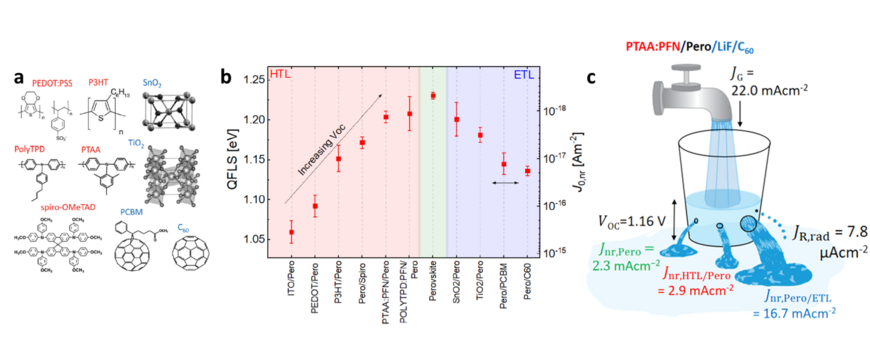Understanding interfacial recombination
Today, the opto-electronic quality of neat perovskite layers can be essentially pushed to it’s radiative limit, however the open-circuit voltage of perovskite solar cells remains limited by significant non-radiative recombination. In particular for pin-type cells, the losses at the top interface to C60 – a common electron transport layer – appears to be omnipresent and typically 1-2 orders of magnitudes larger than all recombination in the perovskite absorber layer. Despite this, interfacial recombination remains poorly understood as much research efforts were targeted at improving the bulk quality and the passivation of electronic defects on the surface. The PotsdamPero group aims at unravelling the processes that govern interfacial recombination with particular focus on understanding the interfacial recombination pathway, the energy level alignmentP4 at the interface, the working mechanism of interlayers, and the presence of back-surface fields which can reduce interfacial recombination.
References
- Wolff, C. M. et al. Nonradiative Recombination in Perovskite Solar Cells: The Role of Interfaces. Adv. Mater. 31, 1902762 (2019).
- Caprioglio, P. et al. On the Relation between the Open‐Circuit Voltage and Quasi‐Fermi Level Splitting in Efficient Perovskite Solar Cells. Adv. Energy Mater.9, 1901631 (2019).
- Stolterfoht, M. et al. The impact of energy alignment and interfacial recombination on the internal and external open-circuit voltage of perovskite solar cells. Energy Environ. Sci.12, 2778–2788 (2019).
- Wolff, C. M. et al. Reduced Interface-Mediated Recombination for High Open-Circuit Voltages in CH3NH3PbI3 Solar Cells. Adv. Mater.29, 1700159 (2017).
- Stolterfoht, M. et al. Voltage-Dependent Photoluminescence and How It Correlates with the Fill Factor and Open-Circuit Voltage in Perovskite Solar Cells. ACS Energy Lett.4, 2887–2892 (2019)..
- Stolterfoht, M. et al. Visualization and suppression of interfacial recombination for high-efficiency large-area pin perovskite solar cells. Nat. Energy3, 847–854 (2018).
- Stolterfoht, M. et al. How To Quantify the Efficiency Potential of Neat Perovskite Films: Perovskite Semiconductors with an Implied Efficiency Exceeding 28%. Adv. Mater.32, 2000080 (2020).
- Zhang, S. et al. The Role of Bulk and Interface Recombination in High‐Efficiency Low‐Dimensional Perovskite Solar Cells. Adv. Mater. 1901090 (2019). doi:10.1002/adma.201901090

